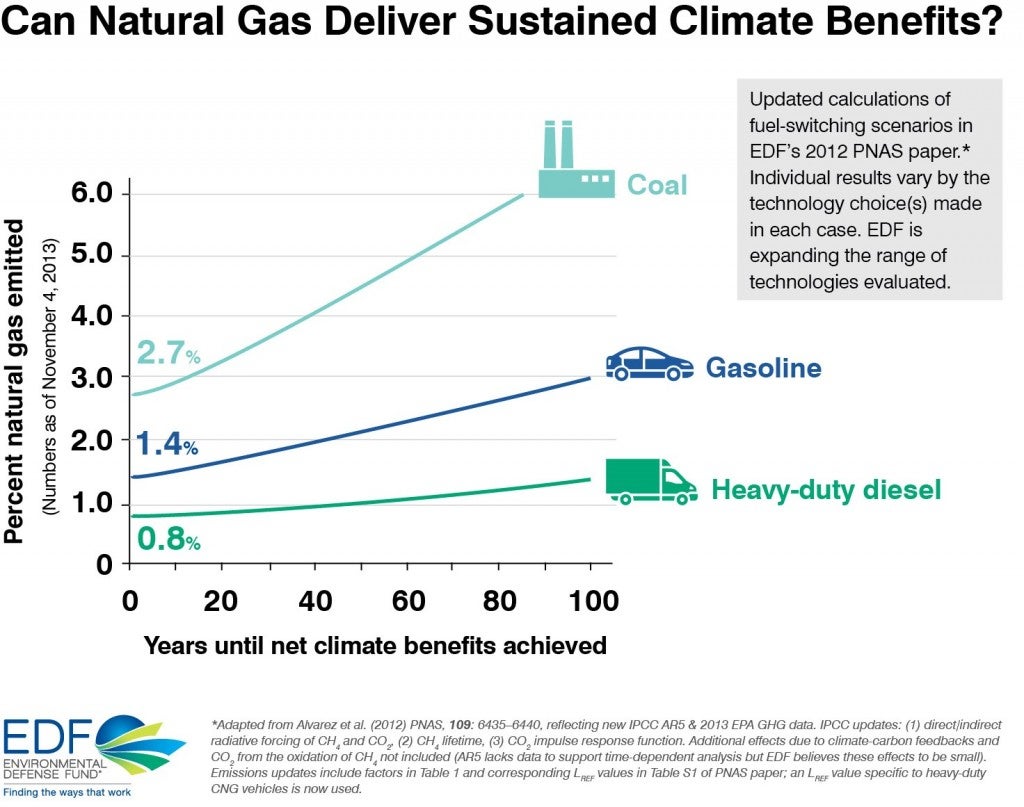 Carbon is typically considered enemy number one in the context of climate-altering pollution. There is good reason why. Carbon dioxide (CO2) emitted from power plants is the leading source of U.S. greenhouse (GHG) emissions. Beyond our borders, the historic level of 400 parts per million of GHGs entering into our earth’s atmosphere was passed just five months ago – an indication of the rapid rise in human-produced emissions.
Carbon is typically considered enemy number one in the context of climate-altering pollution. There is good reason why. Carbon dioxide (CO2) emitted from power plants is the leading source of U.S. greenhouse (GHG) emissions. Beyond our borders, the historic level of 400 parts per million of GHGs entering into our earth’s atmosphere was passed just five months ago – an indication of the rapid rise in human-produced emissions.
And while reducing carbon pollution is the primary goal of EDF’s climate agenda, so is minimizing methane emissions from natural gas development. That’s because methane, the main ingredient in natural gas, is a powerful GHG that can cause major climate damage in the short term. In fact, a recent analysis by many of the world’s top experts on evolving climate science, the Intergovernmental Panel on Climate Change (IPCC), reports methane to be at least 84 times more potent than CO2 over the first two decades. On a 100-year timeframe, methane is at least 28 times more potent. These are noticeable changes in methane’s Global Warming Potential (GWP) from the IPCC’s last assessment in 2007, with values raised from 72 to 84 and 25 to 28, roughly a 17 percent increase on a 20-year time horizon and a 12 percent increase on a 100-year basis.
IPCC’s fifth assessment (AR5) also quantitatively discusses two additional indirect effects that further increase, albeit modestly, methane’s GWP. First, IPCC considers climate-carbon feedbacks and reports two sets of GWP values: one that accounts for the feedbacks and another that excludes them (they conclude that including this effect is “likely” to give a more accurate estimate of climate impacts from emissions of greenhouse gases like methane or CH4). The 20-year GWP for methane with feedbacks increases from 84 to 86, with the 100-year GWP up from 28 to 34. The explanation for this feedback is diminishing ability of oceans and soils to absorb carbon dioxide as the climate warms. As a result, as methane emissions warm the climate, more CO2 that would have historically been absorbed by the land and ocean remains in the atmosphere, causing additional warming. The second effect now quantified by the IPCC is the production of additional CO2 as CH4 is oxidized in the atmosphere, which adds another point or two to methane’s GWP.
Another new development in IPCC’s AR5 is the increased attention devoted to an alternative metric, Global Temperature change Potentials (GTP), in addition to considering GWP based implications. In contrast to the former assessment where GWP was the recommended metric, IPCC does not explicitly make a judgment about whether GTP or GWP is better to use when analyzing methane’s climate impact. Between the two, the difference in short to medium-term implications of using one metric over the other is limited. Over the longer-term (100 years), the GTP metric suggests that methane emissions today are less important on future climate than are indicated by GWP values. However, the implications of either metric are the same: reducing methane emissions quickly is essential to gain climate benefits over the next ten to 20 years, as well as the critical importance of reducing carbon emissions for their long-term impacts.
As the science is evolving, so is our understanding. EDF scientists re-ran the underlying math behind the widely referenced breakeven points in the 2012 Alvarez et al. paper, published in the Proceedings of National Academy of Sciences that helped us better answer questions about whether natural gas can offer sustained climate benefits. Based on IPCC’s AR5 and the Environmental Protection Agency’s (EPA) 2011 Greenhouse Gas Inventory (released in 2013), the revised understanding of when the amount of total methane emissions affects the climate negatively or positively relative to switching from coal or oil to natural gas under specific technology scenarios is shown in this image.
Under the coal to natural gas fuel-switching scenario, natural gas is indicated to be better for the climate than coal on the day the switch is made if less than 2.7 percent of natural gas produced is emitted before the point of use, versus the former 3.2 percent. Similarly, transitioning a gasoline fleet to run on compressed natural gas (CNG) is estimated to be better for the climate so long as the natural gas emitted is below 1.4 percent, instead of 1.6 percent. Factoring these new inputs into the last fuel-switching scenario, class 8 heavy-duty vehicles operated with a compression-ignition engine burning ultra-low sulfur diesel versus a spark-ignition CNG engine, a net positive for the climate is only achieved if no more than 0.8 percent of gas produced is lost to the atmosphere. To put these values into context, the current well-to-pump natural gas loss rate estimate that is based on methane emissions data from the latest EPA inventory is 1.5 percent of total natural gas produced.
These tipping points greatly depend on the type of technology choices made. For example, in the coal comparison, the threshold would vary if a different assumption was used to compare a new natural gas plant versus an existing coal plant, since the 2.7 percent is applicable only to an efficient combined cycle natural gas plant versus an efficient supercritical pulverized coal plant burning low-gassy coal. There are fewer scenarios to consider in the power sector than in transportation, given the development of new LNG (liquefied natural gas) and CNG engines for commercial trucking. As such, it becomes more difficult to pinpoint a single target where under all technology scenarios natural gas delivers sustained climate benefits. EDF scientists are further analyzing the most viable technologies for fleet conversions and will report their findings in 2014.
Overall, the science continues to reinforce the significant impact of methane, and it is critical that these emissions come down in order to reduce the rate of climate change over the coming decades – and the ecological and social disruptions that come with them. Focusing our attention on methane, along with carbon, makes sense given the reduction opportunities and technologies that exist. Now it is critical to put the data currently being collected by a diverse group of EDF’s academic and industry partners to work in minimizing the amount of methane lost to the atmosphere a reality, and soon.










